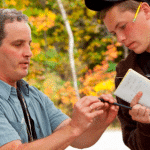Launching School Boards into the 21st Century
CompetencyWorks Blog

Several weeks ago, I attended the CCSSO Innovation Lab Network meeting as a member of the New Hampshire team. At that meeting, Nick Donahue of the Nellie Mae Education Foundation spoke about how we must effectively message our work. After researching several of the resources he outlined (see wiki for the Frameworks Institute report Preparing America for the 21st Century: Values that Work in Promoting Education Reform), one important thought emerged and resonated with me as I prepared for a retreat with a school board and Principal of a traditional high school who wanted to know more about competency education.
I followed Nick’s advice as I designed the three hour work session with the first third of the meeting based on why we must prepare our students for the future. After doing a visioning exercise for the board to imagine what learning will look like on the campus in ten years, the members engaged and voiced many futuristic thoughts and ideas. It laid the groundwork for the discussion on college and career ready skills, competency frameworks, rich performance assessment and grade system reform.
At one point in the presentation, the board members became my ‘students’ and I launched them into a rich performance task (see below), having them unpack what they would have to do to tackle the problem, and then showed them how this work fit the competencies and the assessment plan I would use as a teacher. All of a sudden this school board was launched into 21st century learning using a competency based learning design. They got it!
As we conversed further about next steps for the high school, the board and the high school leadership recognized that this shift will require good strategic planning of resources as well as some rich professional development. This high school has strong curriculum leadership but a veteran staff that is resistant to changing traditional teaching and learning practices as well as grading practices. The staff currently feels a sense of ‘initiative overload’ . Not wanting this school transformation to be seen as another task that will come and go, grading reform and competency design will be the focus. On the horizon will be other transformational practices that will be embraced as the work on grading and competency design reveals the next step.
I left my experience with this board with a positive sense that what happened in that room that afternoon was really important for the future of this educational community. I also left with the resolve that we must develop and support our school leaders who are doing this work.
Through Competency Works, we have many spotlight schools and programs to help inform our work. Perhaps some case studies from the leadership perspective may provide the needed resources for our school leaders to learn and craft their vision and design of competency education for their school communities. As a leader in moving your school organizations to competency education, what resources would be most helpful to you?
Below is the performance task I designed based on a local community resource:
You are a member of Big Island Pond’s Milfoil Management Committee. You are responsible for creating a presentation to lake residents on the effect of milfoil on the lake and how the lake residents can best manage it. The board really went to it, unpacking all the things they would need to know. Then came the big reveal. The next slide had all of the competencies and performance indicators that the students would be meeting in doing this work. It moved them from the conventional teach it first, test it later to understanding that the learning was ‘just in time’, framed by pushing their ideas further, and very differentiated because they could choose how they wanted to work and what medium they would be working in for the product.
(See post on project-based learning for more information)